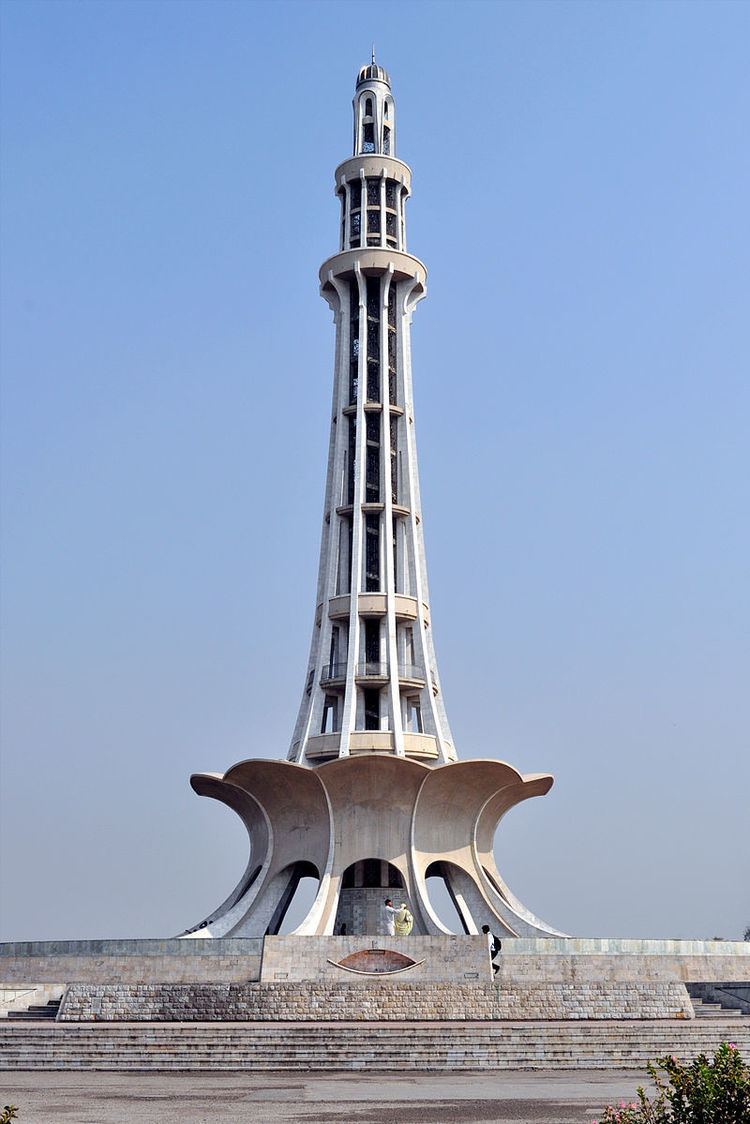Type Public monument Roof 62 metres (203 ft) Height 70 m Construction started 23 March 1960 | Completed 21 October 1968 Structural engineer Aun Muhammad Opened 21 October 1968 | |
 | ||
Similar Badshahi Mosque, Lahore Fort, Iqbal Park, Shalimar Gardens - Lahore, Wazir Khan Mosque | ||
Minar e pakistan lahore
Minar-e-Pakistan (Urdu: مینارِ پاکستان / ALA-LC: Mīnār-i Pākistān, literally "Tower of Pakistan") is a public monument located in Iqbal Park which is one of the largest urban parks in Lahore, Punjab, Pakistan. The tower was constructed during the 1960s on the site where, on 23 March 1940, the All-India Muslim League at the time of British colonial rule over British India passed the Lahore Resolution, the first official call for a separate homeland for the Muslims living in South Asia, in accordance with the two-nation theory.
Contents
- Minar e pakistan lahore
- Minar e pakistan aur manto park ki sair
- Design
- Structure
- Inscriptions
- Political Stands
- References
Minar e pakistan aur manto park ki sair
Design
The tower reflects a blend of Mughal/Islamic and modern architecture.
The tower was designed and supervised by Nasreddin Murat-Khan, an architect and engineer hailing from Daghistan. The structural design was performed by Nasreddin Murat-Khan (a qualified engineer himself), assisted by Engineer Abdur Rehman Khan Niazi, who was working as Structural Design Engineer for Illeri N. Murat-Khan & Associates. Approved by the President, the design was built by Mian Abdul Khaliq and Company. The foundation stone was laid on 23 March 1960. Construction took eight years, and was completed on 21 October 1968 at an estimated cost of Rs 7,058,000. The money was collected by imposing an additional tax on cinema and horse racing tickets at the demand of Akhtar Hussain, governor of West Pakistan. Today, the minaret provides a panoramic view to visitors who can't climb up the stairs or access the top by means of an elevator. The parks around the monument include marble fountains and an artificial lake.
Structure
The base is about 8 metres above the ground. The tower rises about 62 metres on the base, the total height of the minar is about 70 metres above the ground. The unfolding petals of the flower-like base are 9 metres high. The diameter of the tower is about 9.75 meters. The rostrum is built of patterned tiles, and faces Badshahi Mosque. The base comprises four platforms. To symbolise the humble beginning of the freedom struggle, first platform is built with uncut stones from Taxila, second platform is made of hammer-dressed stones, whereas third platform is of chiselled stones. Polished white marble at the fourth and final platform depicts the success of the Pakistan Movement. Mr. Mukhtar Masood, a prolific writer and the then–deputy commissioner of Lahore, was one of the members of the Building Committee. Mian Abdul Khaliq and Company went on to build many other landmarks of Pakistan including the Gaddafi Stadium and BRB Canal.
Inscriptions
At the base, there are floral inscriptions on ten converging white marble Commemorative plaques. The inscriptions include the text of Lahore Resolution in Urdu, Bengali and English, and Delhi Resolution's text, which was passed on 9 April 1946. On different plaques, Quranic verses and 99 attributes of Allah are inscribed in Arabic calligraphy, whereas National Anthem of Pakistan in Urdu and Bengali, excerpts from the speeches of Muhammad Ali Jinnah, in Urdu, Bengali and English, along with few couplets of Allama Iqbal include the other important inscriptions.
Political Stands
Minar-e-Pakistan has served as the location for a number of rallies.
